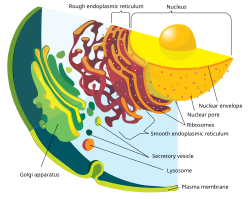Nuclear membrane
The nuclear membrane (or nuclear envelope) is the membrane inside a cell around the nucleus. It has the genetic material (chromosomes and DNA) and the nucleolus inside it.[1][2][3] The membrane forms a double layer.[4] It is connected to another group of membranes in the cell, the endoplasmic reticulum.
The membranes or envelope is a double lipid bilayer membrane which surrounds the chromosomes and nucleolus in eukaryotic cells.[3]
The nuclear membrane has thousands of nuclear pores. They are large hollow proteins about 100 nm across, with an inner channel about 40 nm wide.[4] They link the inner and outer nuclear membranes.
During cell division, the nuclear membrane breaks down to allow mitosis to take place.
Nuclear Membrane Media
A volumetric surface render (red) of the nuclear envelope of one HeLa cell. The cell was observed in 300 slices of electron microscopy, the nuclear envelope was automatically segmented and rendered. One vertical and one horizontal slice are added for reference.
Breakdown and reassembly in mitosis
References
- ↑ "Nuclear membrane". Biology Dictionary. Biology Online. Retrieved 7 December 2012.
- ↑ "nuclear membrane". Merriam Webster. Retrieved 7 December 2012.
- ↑ 3.0 3.1 "The inner nuclear membrane: simple, or very complex?". The EMBO Journal. April 19, 2001. Retrieved 7 December 2012.
- ↑ 4.0 4.1 Hetzer, Mertin (2010). "The nuclear envelope". National Center for Biotechnology Information. 2 (3): a000539. doi:10.1101/cshperspect.a000539. PMC 2829960. PMID 20300205.




